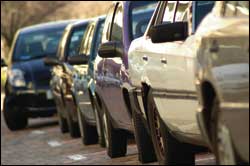Road to a car-free campus
21 August 2006
It'll drive you crazy: UCT management has a plan or two to sort out parking problems on upper campus.
Administrators will tell you that UCT's Campus Access Guide Plan has some broad objectives, notably to provide safe access - in an environmentally-friendly way - to staff, students and visitors. But even they know that for now and the foreseeable future, sorting out the parking problem on upper campus remains top of their to-do list.
Deputy vice chancellor Professor Martin Hall even suggested a headline to campus reporters at the first of two Town Hall Meetings last week, when management presented students with its proposed Campus Access Guide Plan. The attention-grabbing headline would go something along the lines of "Undergraduates can no longer park on campus after 2009".
Hall may have been joking, but that about sums up the plan. Come 2009, only students with a first degree will be allowed to park on campus. (Administrators know that the first-degree thing is going to spark plenty of debate.)
The Campus Access Guide Plan has a bigger picture in mind than just parking, of course, but no one's kidding themselves that the parking problem on upper campus and its spillover into Mowbray and Rondebosch is a growing headache. Student parking bays on campus are projected to be oversold by a ratio of 3.5:1, so they're jamming their cars into every vacant nook and cranny they can find, both on and off campus.
"The system is just not tenable," said Geoff de Wet, director of the Physical Planning Unit, at last week's meetings. "It's just not credible."
The solution on the table is multi-pronged, and includes the following:
- Move the Faculty of Commerce - and its some
5 000 students - from upper campus to the middle campus. - Close off University Avenue (and other heavy student traffic areas) to cars and turn it into a pedestrian precinct.
- Reduce the number of parking bays for students on upper campus from
1 020 to 690. - Reduce the number of student parking bays on the middle and lower campuses from 430 to 67.
- Up the number of visitor bays from 100 to 181. (About
4 700 people visit UCT every month.) - Push up the cost of parking discs gradually over the next few years.
- Set up four or five more safe and secure park-and-ride areas. The university is committed to these satellite sites that will tie in with the Jammie Shuttle route, stressed Hall.
- And - here's the rub for some students - only allow students with a first degree to park on campus come 2009. (Others can use the park-and-ride areas and jump on a Jammie Shuttle.) Postgraduates and students with special needs will still qualify for bays.
All in all, it's projected that these steps will reduce the parking disc to parking spot ratio from the projected 3.5:1 to 1.9:1. And, as a bonus, students won't have to dodge any more cars when crossing University Avenue.
Recent studies and surveys by the Physical Planning Unit suggest that the Jammie Shuttle is a viable option for many more students. According to one survey, 27% of undergraduates with parking discs live within a 10-minute walk of a train station; 29% live within 10 minutes of a public bus route; 21% live within 10 minutes of a Jammie Shuttle route; and 36% within one of the proposed extended routes.
"Essentially, about 45% of students who buy discs live so close to the university they can see it," said Hall.
Administrators will now have to see if students bite. Unfortunately, only a handful attended last week's meetings and feedback will probably only flow in once Varsity hits the tarmac.
 This work is licensed under a Creative Commons Attribution-NoDerivatives 4.0 International License.
This work is licensed under a Creative Commons Attribution-NoDerivatives 4.0 International License.
Please view the republishing articles page for more information.










